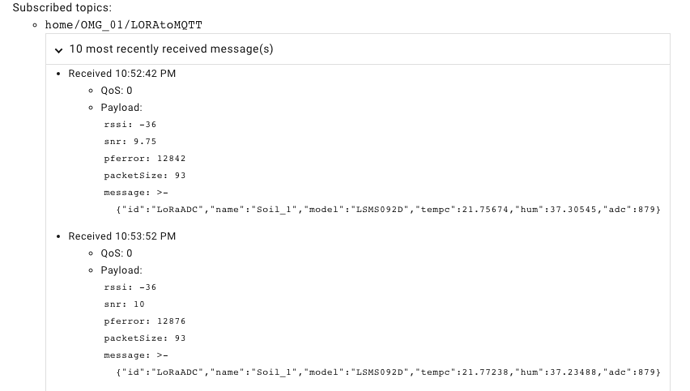Hi folks,
I found these LoRa soil sensors and they’re exactly what i’ve been looking for for!
I think i’ve gotten the code to format a proper json message:
#include <avr/wdt.h>
#include <avr/sleep.h>
//#include <RadioLib.h>
#include "I2C_AHT10.h"
#include <Wire.h>
#include <SPI.h>
#include <LoRa.h>
#include <ArduinoJson.h>
#define NODENAME "Soil_1"
#define DIO0 2
#define DIO1 6
#define DIO2 7
#define DIO5 8
#define LORA_RST 4
#define LORA_CS 10
#define SS 10 // GPIO18 -- SX1278's CS
#define RST 4 // GPIO14 -- SX1278's RESET
#define DI0 2 // GPIO26 -- SX1278's IRQ(Interrupt Request)
#define BAND 915E6
//#define SPI_MOSI 11
//#define SPI_MISO 12
//#define SPI_SCK 13
#define SPI_MOSI 11
#define SPI_MISO 12
#define SPI_SCK 13
//#define SPI_SS 10
int ledPin = 13;
int shu = 0;
int sensorPin = A2; // select the input pin for the potentiometer
int sensorPowerCtrlPin = 5;
int sensorValue = 0; // variable to store the value coming from the sensor
int16_t packetnum = 0; // packet counter, we increment per xmission
float temperature = 0.0; //
float humidity = 0.0;
//float dewpoint = 0.0;
String errcode = "";
// SX1278 radio = new Module(LORA_CS, DIO0, LORA_RST, DIO1, SPI, SPISettings());
AHT10 humiditySensor;
ISR(WDT_vect)
{
Serial.print("[Watch dog]");
Serial.println(shu);
delay(100);
shu++;
wdt_reset();
}
void setup()
{
wdt_disable();
pinMode(ledPin, OUTPUT);
Serial.begin(115200);
Serial.println("[Start]");
delay(100);
SPI.begin();
//setup start
Serial.println("[Setup]");
delay(100);
// initialize SX1278 with default settings
Serial.println(String("Sensor name is :") + String(NODENAME));
Serial.print(F("Initializing ... "));
SPI.begin();
LoRa.setPins(SS,RST,DI0);
if (!LoRa.begin(915E6)) {
Serial.println("Starting LoRa failed!");
while (1);
}
// else
// {
// Serial.print(Success!));
// Serial.println("LoRa ok");
// while (0)
// ;
// }
LoRa.sleep();
//AHT10
pinMode(sensorPowerCtrlPin, OUTPUT);
digitalWrite(sensorPowerCtrlPin, HIGH); //Sensor power on
Wire.begin();
if (humiditySensor.begin() == false)
{
Serial.println("AHT10 not detected. Please check wiring. Freezing.");
}
else
Serial.println("AHT10 acknowledged.");
read_sensor();
//setup over
low_power_set();
}
void loop()
{
wdt_disable();
if (shu > 7) //(7+1) x 8S
{
//code start
Serial.println("Code start*************************************");
read_sensor();
//code end
Serial.println("Code end*************************************");
//count init
shu = 0;
}
watchdog_init();
delay(10);
sleep_cpu();
}
//Set low power mode and into sleep
void low_power_set()
{
Serial.println("[Set]Sleep Mode Set");
delay(100);
set_sleep_mode(SLEEP_MODE_PWR_DOWN);
sleep_enable();
watchdog_init();
delay(10);
sleep_cpu();
}
//Enable watch dog
void watchdog_init()
{
MCUSR &= ~(1 << WDRF);
WDTCSR |= (1 << WDCE) | (1 << WDE);
//WDTCSR = 1 << WDP1 | 1 << WDP2; //1S
WDTCSR = 1 << WDP0 | 1 << WDP3; //8S
WDTCSR |= _BV(WDIE); //not rst, inter interrutp
wdt_reset();
}
void read_sensor()
{
digitalWrite(sensorPowerCtrlPin, HIGH); //Sensor power on
for (int i = 0; i < 3; i++)
{
sensorValue = analogRead(sensorPin);
delay(200);
if (humiditySensor.available() == true)
{
temperature = humiditySensor.getTemperature();
humidity = humiditySensor.getHumidity();
}
if (isnan(humidity) || isnan(temperature))
{
Serial.println(F("Failed to read from AHT sensor!"));
}
}
digitalWrite(sensorPowerCtrlPin, LOW); //Sensor power on
String lora_msg = "#" + (String)packetnum +" NAME:" + (String)NODENAME + " H:" + (String)humidity + "% T:" + (String)temperature + " C" + " ADC:" + (String)sensorValue;
StaticJsonBuffer<200> jsonBuffer;
JsonObject& root = jsonBuffer.createObject();
root["id"] = "LoRaADC";
root["name"] = NODENAME;
root["model"] = "LSMS092D";
root["tempc"] = temperature;
root["hum"] = humidity;
//root[" Dew Point"] = dewpoint;
root["adc"] = sensorValue;
//root["topic"] = home/OMG_01/LORAtoMQTT;
//JsonArray& data = root.createNestedArray("data");
//data.add(temperature,6); // 6 is the number of decimals to print
//data.add(humidity); // if not specified, 2 digits are printed
//root.printTo(Serial);
//root.printTo(LoRa);
// This prints:
// {"sensor":"gps","time":1351824120,"data":[48.756080,2.302038]}
Serial.println(lora_msg);
packetnum++;
LoRa.beginPacket();
// LoRa.print("test");
root.printTo(LoRa);
// LoRa.print(temperature);
// LoRa.print(humidity);
// LoRa.print((String)sensorValue);
LoRa.endPacket();
// radio.transmit(lora_msg);
delay(1000);
LoRa.sleep();
}
but I don’t know much about code… i just cobbled this together from examples I found… so maybe my json isn’t correct?
It looks like this when sent over LoRa to OpenMqttGateway:
{“id”:“LoRaADC”,“name”:“Soil_1”,“model”:“LSMS092D”,“tempc”:23.01273,“hum”:47.26543,“adc”:879}
i’m trying to get the values to show up as usable data that I can plot on a graph as opposed to a string of characters…
I’ve tried this:
- platform: mqtt
state_topic: 'home/OMG_01/LORAtoMQTT' # MQTT topic, check MQTT messages; replace AA... with id (BLE MAC) of your device
name: "Soil_1_ADC"
unit_of_measurement: 'µS/cm'
value_template: '{{ value_json.adc.value"] }}'
expire_after: 21600 # 6 hours
and this:
value_template: '{{ value_json.adc }}'
and this
value_template: '{{ value_json["adc"] }}'
can anyone help me figure out how to derive the values form my json string? (Is my json correct)?
and finally I see this in the MQTT debug info of the OMG device:
Subscribed topics:
home/OMG_01/LORAtoMQTT
1 most recently received message(s)
Received 7:12:48 PM
QoS: 0
Payload: rssi: -35
snr: 10.25
pferror: 12608
packetSize: 93
message: >-
{"id":"LoRaADC","name":"Soil_1","model":"LSMS092D","tempc":23.01273,"hum":47.26543,"adc":879}
Thanks in advance!!







